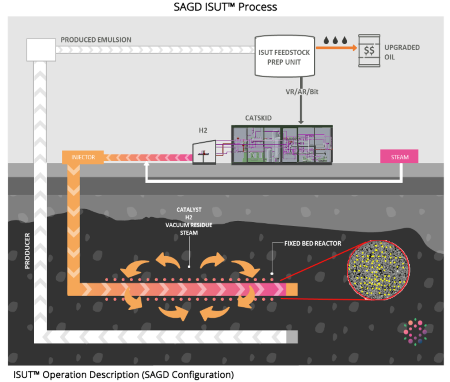Technology developed at University of Calgary is poised to transform oil sands industry
Mark LoweyJanuary 24, 2024
Alberta’s oil sands industry has long been criticized for producing “dirty oil.” Pedro Pereira-Almao with his technology is ready to change that picture – and in doing so transform the industry.
 Pereira-Almao (photo at right) spent more than 17 years at the University of Calgary researching, developing and lab-testing his nanocatalyst-based technology, aimed at changing how the industry produces oil derived from bitumen deposits in oil sands reservoirs.
Pereira-Almao (photo at right) spent more than 17 years at the University of Calgary researching, developing and lab-testing his nanocatalyst-based technology, aimed at changing how the industry produces oil derived from bitumen deposits in oil sands reservoirs.
He is now professor emeritus at UCalgary and chief technology officer of NanosTech, a UCalgary spinoff. The energy transition company has signed an agreement with one of Canada’s largest oil sands producers to field-validate NanosTech’s “in situ upgrading technology” (ISUT™) at the producer’s oil sands production facility in northern Alberta.
The $33.6-million project has received $5 million from Emissions Reduction Alberta and $500,000 from Alberta Innovates.
“The technology is now ready to be demonstrated,” Pereira-Almao told Research Money. “All the components have been sufficiently investigated, modelled and engineered.”
Construction of the demonstration project is expected to start this spring, he said. In addition to having the Alberta oil sands producer’s financial commitment for the project, NanosTech has secured support from a Houston-based major chemical operator of oilfields. Both companies will be identified when the project is officially announced.
 Currently, Alberta oil sands producers use a technology called steam-assisted gravity drainage (photo at right shows SAGD injection wells) to recover bitumen trapped within porous rocks in the reservoir. Pressurized steam is injected into the reservoir to heat and soften the dense and viscous bitumen, so it can flow into production wells. The process requires a lot of water and energy to produce the steam and generates substantial carbon dioxide emissions – making oil and gas extraction the highest greenhouse gas-emitting industry in Canada.
Currently, Alberta oil sands producers use a technology called steam-assisted gravity drainage (photo at right shows SAGD injection wells) to recover bitumen trapped within porous rocks in the reservoir. Pressurized steam is injected into the reservoir to heat and soften the dense and viscous bitumen, so it can flow into production wells. The process requires a lot of water and energy to produce the steam and generates substantial carbon dioxide emissions – making oil and gas extraction the highest greenhouse gas-emitting industry in Canada.
Once at the surface, the recovered bitumen must be upgraded in refineries into heavy oil – also an energy- and emissions-intensive process. Then a thinning agent called diluent (often a natural gas condensate) must be added to the heavy oil so it can flow in pipelines for transport to customers for further refining.
Pereira-Almao’s in situ upgrading technology aims to change all that. The key ingredient is catalysts – molecular compounds that can increase the speed and efficiency of naturally occurring chemical reactions.
 His technology (see illustration at right, courtesy NanosTech) utilizes a patented "CatSKID" module to transform "VR" (the heaviest fraction of residual crude oil from the reservoir) into a highly chemically reactive nanocatalyst that's suspended in the VR. Nanocatalyst suspended in heated VR, and combined with hydrogen and steam, are then injected into the reservoir .
His technology (see illustration at right, courtesy NanosTech) utilizes a patented "CatSKID" module to transform "VR" (the heaviest fraction of residual crude oil from the reservoir) into a highly chemically reactive nanocatalyst that's suspended in the VR. Nanocatalyst suspended in heated VR, and combined with hydrogen and steam, are then injected into the reservoir .
The small size and high reactivity of the nanocatalyst allows it to continuously bind to the sand grains surrounding the injection well, creating a permanent fixed nanocatalyst bed. The process triggers a chemically driven upgrading reaction in the reservoir, while significantly reducing water and steam usage and carbon dioxide emissions. Essentially, the technology turns the reservoir into a catalytic reactor. (See video of the process here).
“By doing that, the light components of oil – the ones that don’t need to be upgraded – are produced,” Pereira-Almao explained. “From the moment you start preparing the nanocatalyst and injecting, you are producing a light oil, which is a medium-quality oil.”
That means oil sands producers will no longer need to upgrade bitumen-derived heavy crude oil in surface refineries. Also, companies will be able to reduce – and in theory eliminate – the use of diluent because they can pipeline higher-quality, less viscous oil to customers.
ISUT™ technology “provides enhanced oil recovery, by both increasing production rates by up to 50 per cent and producing over 90 per cent total recovery of original oil and place,” Emissions Reduction Alberta (ERA) said in awarding $5 million to the demonstration project.
When combined with SAGD technology, the technology reduces water and steam requirements by up to 43 per cent and reduces greenhouse gas emissions by up to 30 per cent, ERA said. “Additionally, ISUT™ upgrades oil quality, offering an opportunity for producers to fetch a premium price while making it more transportable, significantly reducing or eliminating the need for costly diluent, further reducing emissions downstream.”
Persistence and support have been crucial in developing the technology
Prior to joining the University of Calgary, Pereira-Almao worked in his native Venezuela for Petróleos de Venezuela, the state oil and gas company, specializing in upgrading and processing heavy oils. This included R&D in Venezuela’s oil sands which – like Alberta’s – are rich in heavy oil.
In 2003, he joined UCalgary’s Schulich School of Engineering, in the chemical and petroleum engineering department. Supported by a joint Natural Sciences and Engineering Research Council of Canada (NSERC)-industry industrial chair, he led research projects focused on nanoparticle and catalyst-based nanotechnologies development.
He also co-founded cleantech startups in Calgary such as Litus, which is developing nanotechnology for lithium production, Carbonova Corp., developing a catalysts-based technology to produce superior carbon nanofibres for numerous applications, and NanosTech.
Many of Pereira-Almao’s fellow Venezuelans followed him to work with him at UCalgary. Several of these colleagues left the university about the same the time he did and are now working at NanosTech. Many of his former students also have joined the company.
“Many of the children of those Venezuelans who came with me are now participating in this initiative,” Pereira-Almao said. “They have become chemists and engineers.”
In 2022, NanosTech was named one of the Foresight 50, the Foresight clean teach accelerator’s list of the 50 “Most Investable Clean tech Ventures.” The 2021 Foresight winners collectively raised more than $593 million to propel their clean technology forward.
In addition to UCalgary’s and NSERC’s support of his research, funding and in-kind contributions over the years also have come from Alberta Innovates, the National Research Council’s Industrial Research Assistance Program, Mitacs, and major oil companies.
NanosTech was close to securing significant funding from Sustainable Technology Development Canada (SDTC), when last October a third-party investigation ordered by Innovation, Science and Economic Development Canada, produced a report that found evidence of inappropriate funding, conflict-of-interest breaches and human resources shortcomings at SDTC. Industry Minister François-Philippe Champagne then suspended SDTC’s ability to provide funding for any new cleantech projects until the problems are addressed to his satisfaction.
Pereira-Almao said he’s hoping that situation can be resolved quickly so the SDTC funding can be obtained. If SDTC’s problems aren’t quickly resolved, however, NanosTech still has sufficient support from other parties to start its demonstration project as scheduled, he said. Other oil sands producers in northern Alberta have signed on as observers for the project.
ISUT™ is a “bolt-on” technology, utilizing a compact catalyst preparation module mounted on a portable skid, that can be added to existing oil sands plants and scaled up as needed.
Naomi Pereria, executive vice-president at NanosTech, said a unique aspect of the company’s agreement with its oil sands producer partner on the project is to fast-track the demonstration plant – once it has been shown to work – immediately into commercialization. Other oil sands producers, if they choose, then could also continue with and expand the demonstration project.
In 2021, Kelowna, B.C.-based clean tech firm Vorsana Environmental Inc., acquired NanosTech with the goals of accelerating commercialization of Pereira-Almao’s nanocatalyst technology and also building a catalytic-based innovation hub in Calgary. Called the “CatHub,” it would be the first-of-its kind catalyst production and optimization centre in Canada.
“We are not giving up on Canadian oil,” Myles McGovern, CEO of Vorsana, said at the time of the acquisition. “The oil sands need to be competitive. We have the technology to significantly reduce GHG emissions, increase pipeline capacity and not compromise the environment.”
Vorsana has 37 patents and has developed 15 different product solutions – including a proprietary waste-to-fuel process for the transportation industry – to reduce greenhouse gas emissions, restore compromised environments, and create sustainable products.
NanosTech developing other applications for nanocatalysts
NanosTech’s nanocatalyst technology has other applications besides oil recovery in Alberta’s oil sands reservoirs. The technology could be used to recover oil in slightly deeper bitumen reservoirs that Venezeula and Columbia have, or in deep carbonate reservoirs like those found in Mexico.
“We can cover practically all kinds of heavy oil reservoirs that we know of,” Pereira-Almao said.
Beyond oil recovery, NanosTech has developed a nanocatalyst-based process for producing hydrogen from natural gas, using lower temperatures and with 35-per-cent lower carbon dioxide emissions compared with the steam-methane reforming technology currently used. The company also is targeting the renewable fuels space with its catalytic upgrading process to convert heavy oils from renewable feedstocks into high-quality fuels.
“We have produced technology for the energy transition and for the hydrogen era,” Pereira-Almao noted.
He pointed out that if NanosTech’s technology is widely adopted by oil sands producers, it would be technologically possible to reverse the current pipeline flow of diluent and instead transport much lighter oil that doesn’t require diluent.
“We are not going to be bitumen producers,” Pereira-Almao said. “We will be bitumen holders in our reservoirs. And we have a technology to make these reservoirs produce conventional oils.”
Alberta's oil production surpassed 4 million barrels per day for the first time in November 2023 – the vast majority of it coming from the oil sands.
According to Emissions Reduction Alberta, “The implementation of ISUT™ stands as a pivotal achievement in advancing Alberta and Canada’s GHG reduction objectives, underpinned by more than 15 years of steadfast research and development.” The upcoming demonstration project sets the stage for the technology to be integrated across the entire heavy oil industry, ERA said.
“What we want is for everybody to use the technology, so we can really have significant economic and environmental benefits,” Pereira-Almao said. As a plus, “the ‘dirty oil’ denomination that weighs so much on us is going to be probably removed.”
R$
Events For Leaders in
Science, Tech, Innovation, and Policy
Discuss and learn from those in the know at our virtual and in-person events.
See Upcoming Events
You have 0 free articles remaining.
Don't miss out - start your free trial today.
Start your FREE trial Already a member? Log in
By using this website, you agree to our use of cookies. We use cookies to provide you with a great experience and to help our website run effectively in accordance with our Privacy Policy and Terms of Service.





